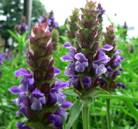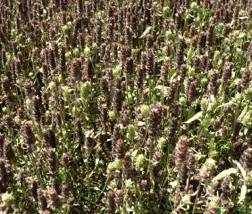Prunella: Purging Fire, Regulating Qi
 Prunella refers to the Chinese herb xiakucao (literally: weed that withers in summer); its purple-flowered spikes turn reddish brown during the summer when they are collected. The herb material is obtained from the plant Prunella vulgaris, which grows across much of the temperate zone of the northern hemisphere. It is produced in most places in China, though mainly in Jiangsu, Anhui, and Henan Provinces (1). In ancient times, the whole tops were collected for use; now only the dried spikes are kept. Prunella is classified as an herb for clearing heat and purging fire, considered to have its primary effect on the syndrome of “liver fire.”
Prunella refers to the Chinese herb xiakucao (literally: weed that withers in summer); its purple-flowered spikes turn reddish brown during the summer when they are collected. The herb material is obtained from the plant Prunella vulgaris, which grows across much of the temperate zone of the northern hemisphere. It is produced in most places in China, though mainly in Jiangsu, Anhui, and Henan Provinces (1). In ancient times, the whole tops were collected for use; now only the dried spikes are kept. Prunella is classified as an herb for clearing heat and purging fire, considered to have its primary effect on the syndrome of “liver fire.”
 Prunella falls under the fire-purging classification because of its use in treating redness and inflammation of the eyes or infections of the skin. It is also known for regulating the circulation of qi, mainly given for resolving accumulations and masses; being of light nature, it is especially used for accumulations in the upper body (chest, throat, and head). In the Shennong Bencao Jing (2), prunella was described as “breaking concretions and dispersing bound qi of the neck.” To this day, it is utilized in formulas for treating thyroid swellings and breast lumps. Prunella has been used for other swellings, for example, it is combined with isatis root for treatment of mumps (3) and added to prescriptions for skin diseases when nodules are present (4). New applications of prunella include treatment of hypertension and viral hepatitis (5).
Prunella falls under the fire-purging classification because of its use in treating redness and inflammation of the eyes or infections of the skin. It is also known for regulating the circulation of qi, mainly given for resolving accumulations and masses; being of light nature, it is especially used for accumulations in the upper body (chest, throat, and head). In the Shennong Bencao Jing (2), prunella was described as “breaking concretions and dispersing bound qi of the neck.” To this day, it is utilized in formulas for treating thyroid swellings and breast lumps. Prunella has been used for other swellings, for example, it is combined with isatis root for treatment of mumps (3) and added to prescriptions for skin diseases when nodules are present (4). New applications of prunella include treatment of hypertension and viral hepatitis (5).
Yang Yifan has described the herb this way (6):
Prunella is bitter, cold, and pungent and enters the liver meridian. Cold and bitterness can reduce liver fire; pungency may disperse stagnant qi and constrained heat. Compared with the other herbs [for clearing liver heat, such as gardenia and gentiana] it has a gentle action of nourishing liver blood. As the liver opens into the eyes, liver fire may in turn lead to disorders of the eyes. Prunella is particularly effective for treating painful and dry eyes; a distending sensation of the eyes which worsens at night or in stressful situations due to weakness of blood; and stagnation of liver qi and liver fire, such as in hypertension and glaucoma. As prunella is pungent and has a dispersing tendency, it is quite different from the other bitter-cold herbs, which have only descending action. It is effective for dissipating lumps and nodules which are caused by stagnation of liver qi and accumulation of phlegm and heat….
The heat-clearing the qi dispersing effects of prunella have been compared to those of bupleurum (chaihu). One of the primary differences is that bupleurum is said to have an “upbearing” action, which is not the case with prunella. Also, because of the ability of prunella to slightly nourish the blood and thus relieve “dryness” of the liver, it can be utilized when there is a concern about chaotically releasing constrained heat of the liver (when utilizing bupleurum, this concern is alleviated by including an adequate dose of the blood nourishing herbs tang-kuei and peony). Symptoms of depressed liver with constrained fire include: irritability and tendency to have outbursts of anger; insomnia; rashes; and ocular inflammation (7).
As noted, prunella has a gentle action; it is a mild herb that can be used in high doses. In Oriental Materia Medica (8), the daily dosage is given as 15–30 grams, though most Chinese texts indicate 10-15 grams (or 9-15 grams) as the standard dosing, sometimes specifying “up to 30 grams.” In the modern treatment of hypertension, a dosage of 30 grams was utilized (5) and this same dose of prunella was also used in a formula for treating thyroid swelling associated with hyperthyroidism (9) and in several published formulas given to patients in China with thyroid tumors (10). In a report on herb formulas for thyroid cyst, prunella at 60 grams per day is recommended during treatment, then every other day to reinforce the curative effects after the cyst is resolved (11).
In Western herbalism, Prunella vulgaris is known as “all-heal” or “self-heal,” reputed to help in the treatment of skin wounds and infections as well as other injuries, such as bruises; it is also thought to be of use in treating internal “wounds” such as ulcers (12). The whole tops are used to make an infusion, with one ounce being a standard daily dose (about 30 grams).
The active constituents of prunella have not been subjected to much study. Some common substances have been found, such as the triterpenoids oleanolic acid, ursolic acid, and betulinic acid; the flavonoids rutin, cyanidin, and delphinidin; and the non-flavonoid phenolics caffeic acid and its dimmer, rosmarinic acid; aromatic components, such as camphor and fenchone; as well as compounds found in the Chinese herb salvia (danshen), such as tanshinone. Quantitative analysis for these components is poorly developed. In one study, a romarinic acid content of 6.1% was reported for prunella spikes (13), which would make this herb the most concentrated source of the compound currently known. But, without more information about constituents and their quantities, there remains little understanding of how the herb produces its claimed effects via modern explanations. The known ingredients will certainly have anti-oxidant and anti-inflammatory action, but there may be other components not yet identified that would help explain the impact on swellings, hypertension, and other disorders as mentioned in the literature. The anti-inflammatory action of prunella has been utilized in a formulation made of extracts of prunella and two other herbs (clematis and trichosanthes), which evaluated over a six week period for effects in rheumatoid arthritis, with claimed comparable action to that of celecoxib (14).
Before the development of effective anti-HIV drug therapies, there was considerable interest in prunella as a potential source of anti-HIV active components. The polysaccharide fraction was one component shown to have in vitro activity against HIV, as had been demonstrated for many other polysaccharides. These compounds turned out to have little clinical benefit when taken orally. Some studies of prunella for inhibiting HIV continue in China and Japan, with the hope of potentially developing a viable herbal drug for those who do not tolerate the standard therapies (15, 16).
Since rosmarinic acid has been studied as a potential treatment for allergic reactions, prunella extract is also being evaluated for that as a new application (17), possibly reflecting the traditional use of the herb for treating rashes.
 Samples of Prunella-containing Products from China
Samples of Prunella-containing Products from China
Tea of prunella and crataegus (shanzha) to clear liver heat and reduce food stagnancy, considered useful in reducing risk factors for cardiovascular disease.
 |
Left: Formula called “Breast Mate Tablet” for breast lumps; includes prunella (among other ingredients are: fritillaria, red peony, bupleurum, curcuma, tang-kuei, cyperus, citrus seed). Right: Prunella formula (Xiakucao Jiedu Wan) in capsules for treating infections of the skin or bones. |
 |
References
- Huang Yarong, compiler, Advanced Textbook on Traditional Chinese Medicine and Pharmacology, volume 2, 1996 New World Press, Beijing.
- Yang Shouzhong, translator, The Divine Farmer’s Materia Medica, 1998 Blue Poppy Press, Boulder, CO.
- Hou Jinglun and Zhang Guixiang, Traditional Chinese Treatment of Infectious Diseases, 1997 Academy Press, Beijing.
- Li Lin, Practical Traditional Chinese Dermatology, 1995 Hai Feng Publishing Company, Hong Kong.
- Chang HM and But PPH, Pharmacology and Applications of Chinese Materia Medica, 1987 World Scientific, Singapore.
- Yang Yifan, Chinese Herbal Medicines: Comparisons and Characteristics, 2002 Churchill-Livingstone, London.
- Chace C and Zhang TL, translators, A Qin Bowei Anthology, 1996 Paradigm Publications, Brookline, MA.
- Hsu HY, et.al., Oriental Materia Medica, 1986 Oriental Healing Arts Institute, Irvine, CA.
- Xia Shaonong, et.al., Hyperthyroidism treated with Yiqiyangyin Decoction, Journal of Traditional Chinese Medicine 1986; 6(2): 79–82.
- Dharmananda S, Treatments for thyroid diseases with Chinese herbal medicine, 1994 START Manuscripts, ITM, Portland, OR.
- Chang Minyi, Anticancer Medicinal Herbs, 1992 Hunan Science and Technology Publishing House, Hunan.
- Grieve M, A Modern Herbal, 1971 Dover Publications, New York, NY.
- Lamaison JL, et.al., Medicinal Lamiaceae with antioxidant properties, a potential source of rosmarinic acid, Pharma Acta Helvetica 1991; 66(7): 185–188.
- Song, et.al., Assessment of comparative pain relief and tolerability of SKI306X compared with celecoxib in patients with rheumatoid arthritis, Clinical Therapeutics 2007; 29(5); 862-873.
- Liu S, et.al., Identification of inhibitors of the HIV-1 gp41 six-helix bundle formation from extracts of Chinese medicinal herbs Prunella vulgaris and Rhizoma cibotte, Life Sciences 2002; 71(15): 1779-1791.
- Kageyama S, et.al., Extract of Prunella vulgaris spikes inhibits HIV replication at reverse transcription in vitro and can be absorbed from intestine in vivo, Antiviral Chemistry and Chemotherapy 2000; 11(2): 157–164.
- Kim SY, et.al., Effects of Prunella vulgaris on mast cell-mediated allergic reaction and inflammatory cytokine production, Experimental Biology and Medicine 2007; 232(7): 921–926.
July 2010